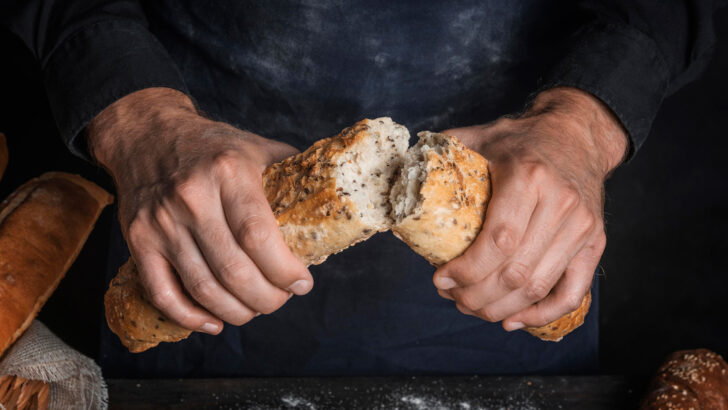Dr Thomas O’Loughlin
Anyone who sees a loaf of bread and slices it knows that there is something very basic about this foodstuff and this action of dividing it. Bread, so the saying goes, is “the staff of life”.
But bread comes to us as loaves, and when we cut them up there is an implicit statement that this is for sharing. Each of us at the table can have a piece, the loaf by being cut up becomes the sustenance of the group that are at the table sharing it.
It might be a long narrow loaf cut into small rounds, a round home-made loaf of brown bread cut into oval shaped slices, or a box-like baker’s loaf that produces more rectangular slices: but always the cutting up enables sharing. Loaves are for sharing.
A basic element: Our earliest catechesis for the meal among the followers of Jesus, from before 58AD, recalls a unique element of Jesus’s practice: at the meal’s beginning he took a loaf and then blessed the Father.
For I received from the Lord what I also handed on to you, that the Lord Jesus on the night when he was betrayed took a loaf of bread, and when he had given thanks, he broke it and said, ‘This is my body that is for you. Do this in remembrance of me.’ (1 Cor 11:23-4).
Recalled
The words Jesus used in thanking the Father were not recalled – the formula of blessing God was known to all – but it was the gestures that were distinctive. He took a loaf of bread. Then he broke it into pieces. Each at table ate a piece. Each had a share in his loaf.
A recalling to unity: For Paul, each eating from a single loaf was a demonstration of their unity. They formed one body: with each other and with the Christ.
The loaf that we break, is it not a sharing in the body of Christ?
Because there is one loaf, we who are many are one body, for we all partake of the one loaf (1 Cor 10:16-7).
The loaf was and is a sign of our belonging within the one body as sisters and brothers with Jesus.
The scattered gathered: Within Christian memory – seen in the Didache (c. 80AD) – the loaf pointed to their being a new people, gathered back by Jesus. Scattered grains, when gathered are transformed in a new unity – a loaf – that could be shared by many.
Then when it comes to the broken loaf, say:
“We give thanks to you, our Father,
for the life and knowledge which you have made known to us.
Through Jesus, your servant, to you be glory forever.
For as the broken loaf was once scattered over the mountains
and then was gathered in and became one,
so may your Church be gathered together into your kingdom
from the very ends of the earth.
Yours is the glory and the power through Jesus Christ forever (9:3-4).”
A real loaf, crusty, aromatic, broken and shared, is a basic Christian symbol.
But in practice? For most Christians nowadays the loaf is only an image, not an experience.
We use pre-cut little round wafers, one for each – ecclesiastical ‘fast food’ – which are symbolically the very opposite of sharing. Each is made as a ‘whole’ for just one person. One can hardly taste it, much less be said to eat it. Has it any of the taste, smell, touch, or sensory joy of a piece of a real loaf, broken and shared?
At a banquet today, the waiter will not only offer you a small loaf, but a choice from a basket of different fresh, warm, loaves. We react to such real food.
What a pity that at the anticipation of the heavenly banquet, the memorial of banquet of Jesus, we use such paltry, artificial stuff! We need to rediscover loaves of real bread in our liturgies; then break and share them.
To read further:
Thomas O’Loughlin, ‘Translating Panis in a Eucharistic Context: A Problem of Language and Theology,’ Worship 78(2004) 226-35.
‘The “Eucharistic Words of Jesus”: An Un-noticed Silence in our Earliest Sources,’ Anaphora 8,1(2014)1-12.
Dr Thomas O’Loughlin is Emeritus Professor of Historical Theology at Nottingham University.


 Breaking bread as an act of sharing.
Breaking bread as an act of sharing. 